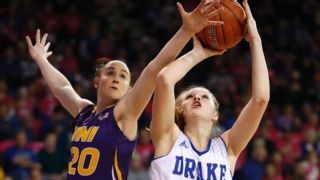|
A team's body of work and the student-athlete experience have been huge themes of the NCAA tournament selection committee over the past decade-plus in putting together each season's bracket. Those ideals have been applied fairly consistently over the past few seasons. That trend hit a snag in 2017, as some seeds in Monday's bracket appear to contradict those principles. Some observations from the 2017 women's NCAA tournament bracket: Regular-season performance in conference play didn't matterThe seeding of a number of teams indicates that this committee didn't take regular-season conference performance into consideration much at all. And that is a bad message. Conference record is supposed to matter. It's a posted criterion. This bracket contains numerous examples of when that was disregarded.  California vs. Oregon: California getting an at-large bid was questionable enough. The Bears were 6-12 in the Pac-12 and lost five of their last six regular-season league games. Not only did Cal make the field but the Bears are a No. 9 seed, one seed line ahead of Oregon. The Ducks finished two games better in the Pac-12 than Cal. But that seemed to be disregarded, as was a better RPI, stronger schedule and better overall record. They each had the same number of top-50 wins. They split during the regular season. Cal does have a win over Oklahoma, but Oregon has a better one over Washington. The seeding here is confusing at best. There's simply no reasonable explanation why Cal would be seeded ahead of the Ducks. Selection committee chair Terry Gawlik hinted that there might have been a procedural bump, which allows for a team to be moved up or down one seed line. If that's what happened, it could have been done better. Cal was one of the last four teams included in the bracket, so its original seed was a No. 10, as was Oregon's. Because of the areas on the bracket of the other Pac-12 teams, one of them had to be bumped to a No. 9 to prevent conference matchups before the Elite Eight. The Ducks, as the higher-ranked team on the S-curve, should have been that team. As a result, Oregon gets a trip to Durham, North Carolina, three time zones away and one of the longest distances any team in the tournament will travel, and the Bears are sent to much closer Waco, Texas. Drake vs. Northern Iowa: If regular-season performance within league play did matter, it's difficult to rationalize the committee's decision to have Northern Iowa and Drake both on the No. 10 line. UNI's inclusion in the field over a team such as Virginia was puzzling enough, but if the committee considered the Missouri Valley Conference -- as the 16th-rated RPI conference -- strong enough for two teams, then the league's unbeaten regular-season and tournament champion deserved a better seed than a No. 10 -- and certainly better than its distant second-place finisher. Drake finished three games ahead of the Panthers in the Missouri Valley season and beat Northern Iowa three times. It's possible that the Bulldogs were considered the best No. 10 seed and Northern Iowa the worst, but that's still too close for two teams that weren't that close all season. Perhaps the committee was mesmerized by UNI's performance in Sunday's MVC tournament title game, which wasn't decided until overtime. Yes, UNI beat Kansas State and Creighton in the nonconference, but that doesn't make up for the head-to-head or conference discrepancy. "Body of work" has to include conference play, but it seemed to be forgotten here.  DePaul vs. Marquette: Another glaring example comes from the Big East, where DePaul, the regular-season champion, was given a No. 7 seed and tournament champ Marquette a No. 5. The seed for the Blue Demons seems particularly low for a team that won a conference and played and competed as well as DePaul did against the No. 11-rated nonconference schedule. True, the Golden Eagles beat DePaul three times this season, but DePaul won the league and finished three full games better than Marquette. The losses the Golden Eagles suffered in the Big East -- such as Providence and St. John's twice -- should count for something, too. A two-seed-line difference seems inequitable. South Carolina to Stockton and Baylor to Oklahoma CityThis is another bad message. For the third time in three years, the Gamecocks are being sent to the farthest possible regional destination. That shouldn't happen, especially not in a year when they earned a better scenario. I get it. Baylor can get to Oklahoma City in a bus. South Carolina and its fans have to fly to either Oklahoma or California. That's the rationale, but it's just not right. If this were the first year the Gamecocks were facing extensive travel, it would be more understandable. It isn't. South Carolina had more RPI top-50 wins than Baylor (13 to 12), more top-25 wins (10-9), a better RPI and a better strength of schedule, plus it played in a better conference and won its regular-season and tournament titles (Baylor did not win the Big 12 tournament). That is why South Carolina is No. 3 on the overall board and Baylor is No. 4 -- but that didn't matter in terms of travel here. If student-athlete experience remains a consideration, what about the South Carolina student-athlete experience? For the third year in a row, senior Alaina Coates could be playing in her third regional as far from campus as possible. I agree it's important to have Big 12 representation in the Oklahoma City Regional, but by putting Baylor there the committee missed an opportunity to put Texas and Oklahoma there. Austin is a mere 100 miles farther from Chesapeake Energy Arena than Waco is. Is that worth compromising the integrity of the bracket? If it is, then why is Stanford, just 91 miles from Stockton, placed in Lexington and Oregon State in Stockton? The Beavers have a flight to either region, too. Based on the South Carolina/Baylor logic, Stanford and Oregon State should be flopped. Committee didn't value the Big TenIt's no secret the Big Ten has slipped in recent years and was particularly down this season. The committee put a major exclamation point on that fact with this bracket. Michigan wasn't included, Ohio State was not put in the top 16 and missed out on hosting the first and second rounds, and Maryland was given a No. 3 seed. All of those could be questioned, but this was at least a consistent theme. Having four teams near or below 200 in the RPI dragged every other member's SOS down. This hurt the conference dearly. The Terrapins might not be happy with their No. 3 seed (No. 9 overall), but being a No. 2 might not have helped. Even if Maryland was a No. 2 and Duke was a No. 3, it appears they both would still have been in the Bridgeport Regional, something that's probably more upsetting to Brenda Frese and her team than the No. 3 seed itself. The hosting HurricanesMiami was selected as the 16th team on the board, and with that comes the ability to host opening-weekend games. However, that No. 4 seed seems a bit high for a team that did little in the nonconference other than beat Ohio State and beat only two of the tournament-quality teams within the ACC. Still, the Hurricanes' top-16 status is palatable until moving down the bracket and seeing Syracuse as a No. 8. Essentially, the committee is saying Miami is No. 16 overall, and at best, the Orange are No. 29. That's a huge discrepancy for a team that finished one game ahead of Miami in the ACC, beat the Hurricanes by 33 and had a better nonconference schedule. Syracuse might have been moved off the No. 7 line to accommodate for bracketing principles, but a deeper dive into the bracket shows it didn't need to be. Nonetheless, even that scenario -- Miami at No. 4 and Syracuse at No. 7 -- is still too much of a disparity to justify. Purdue and Ohio State in the same subregional?The committee seemed to go out of its way in its attempt to keep conference teams away from meeting before the Elite Eight (see the above Cal example). However, the committee put No. 9 Purdue in the same subregional as No. 5 Ohio State. There are only four Big Ten teams in the field, so this was completely unnecessary. In fact, the Boilermakers easily could have been placed in the Waco subregional and Cal in South Bend, Indiana, to avoid what appears to be a mistake. Travel for the Bears to Notre Dame as opposed to Baylor can't be the consideration; Oregon is already going to Durham unnecessarily, and Toledo is off to Corvallis, Oregon.
|
